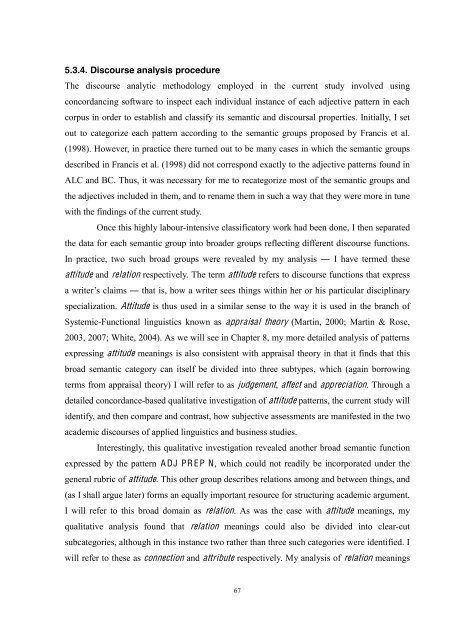Evaluative Meanings and Disciplinary Values - eTheses Repository ...
Evaluative Meanings and Disciplinary Values - eTheses Repository ...
Evaluative Meanings and Disciplinary Values - eTheses Repository ...
Create successful ePaper yourself
Turn your PDF publications into a flip-book with our unique Google optimized e-Paper software.
5.3.4. Discourse analysis procedure<br />
The discourse analytic methodology employed in the current study involved using<br />
concordancing software to inspect each individual instance of each adjective pattern in each<br />
corpus in order to establish <strong>and</strong> classify its semantic <strong>and</strong> discoursal properties. Initially, I set<br />
out to categorize each pattern according to the semantic groups proposed by Francis et al.<br />
(1998). However, in practice there turned out to be many cases in which the semantic groups<br />
described in Francis et al. (1998) did not correspond exactly to the adjective patterns found in<br />
ALC <strong>and</strong> BC. Thus, it was necessary for me to recategorize most of the semantic groups <strong>and</strong><br />
the adjectives included in them, <strong>and</strong> to rename them in such a way that they were more in tune<br />
with the findings of the current study.<br />
Once this highly labour-intensive classificatory work had been done, I then separated<br />
the data for each semantic group into broader groups reflecting different discourse functions.<br />
In practice, two such broad groups were revealed by my analysis I have termed these<br />
attitude <strong>and</strong> relation respectively. The term attitude refers to discourse functions that express<br />
a writers claim that is, how a writer sees things within her or his particular disciplinary<br />
specialization. Attitude is thus used in a similar sense to the way it is used in the branch of<br />
Systemic-Functional linguistics known as appraisal theory (Martin, 2000; Martin & Rose,<br />
2003, 2007; White, 2004). As we will see in Chapter 8, my more detailed analysis of patterns<br />
expressing attitude meanings is also consistent with appraisal theory in that it finds that this<br />
broad semantic category can itself be divided into three subtypes, which (again borrowing<br />
terms from appraisal theory) I will refer to as judgement, affect <strong>and</strong> appreciation. Through a<br />
detailed concordance-based qualitative investigation of attitude patterns, the current study will<br />
identify, <strong>and</strong> then compare <strong>and</strong> contrast, how subjective assessments are manifested in the two<br />
academic discourses of applied linguistics <strong>and</strong> business studies.<br />
Interestingly, this qualitative investigation revealed another broad semantic function<br />
expressed by the pattern A DJ PR EP N, which could not readily be incorporated under the<br />
general rubric of attitude. This other group describes relations among <strong>and</strong> between things, <strong>and</strong><br />
(as I shall argue later) forms an equally important resource for structuring academic argument.<br />
I will refer to this broad domain as relation. As was the case with attitude meanings, my<br />
qualitative analysis found that relation meanings could also be divided into clear-cut<br />
subcategories, although in this instance two rather than three such categories were identified. I<br />
will refer to these as connection <strong>and</strong> attribute respectively. My analysis of relation meanings<br />
67
















